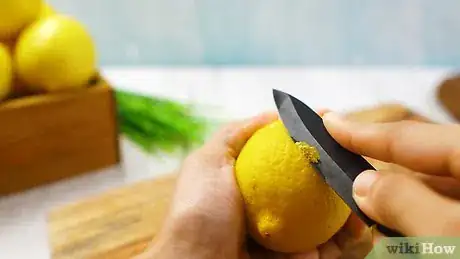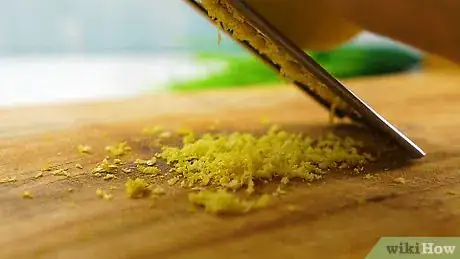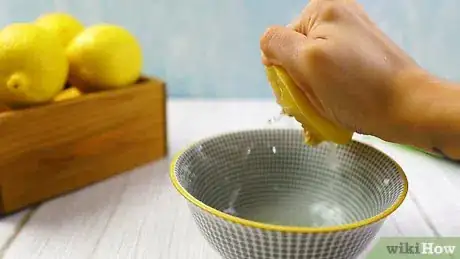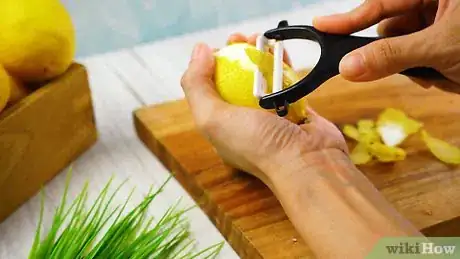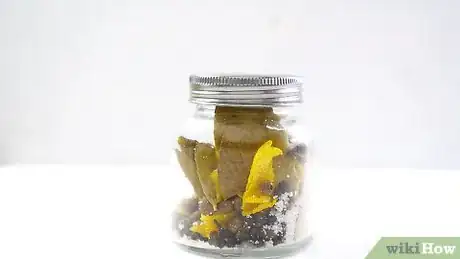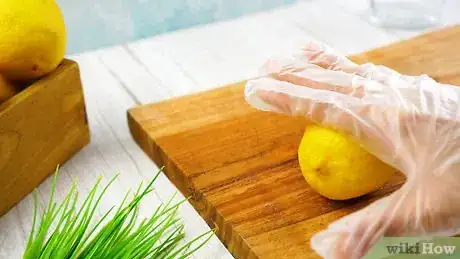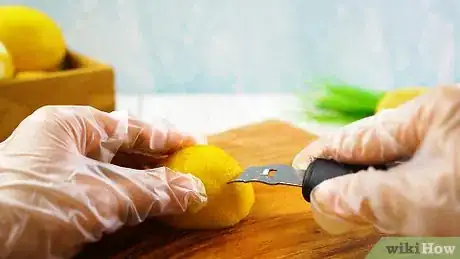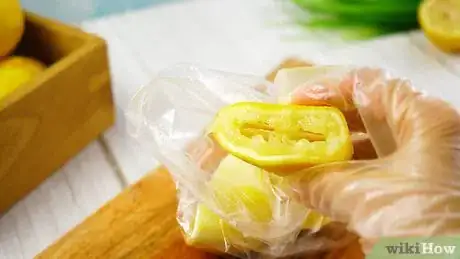This article was co-authored by wikiHow Staff. Our trained team of editors and researchers validate articles for accuracy and comprehensiveness. wikiHow's Content Management Team carefully monitors the work from our editorial staff to ensure that each article is backed by trusted research and meets our high quality standards.
There are 16 references cited in this article, which can be found at the bottom of the page.
The wikiHow Culinary Team also followed the article's instructions and verified that they work.
This article has been viewed 64,370 times.
Learn more...
Lemon peel, along with other citrus skins, has been used for centuries in food and drink recipes. Originally from Asia, lemon has become important to European, Middle Eastern and Asian cuisines.[1] There are dozens of lemon varieties, all of which can be preserved, though some varieties have oilier, and thus more fragrant, skin.[2] Preserving lemon peel is a worth the effort, since fresh lemons are not in season year-round. Packed with vitamins A and C, potassium, fiber, polyphenol flavonoids that help lower LDL cholesterol, and calcium, preserved lemon peel can provide many nutritional benefits, particularly when eaten regularly.[3] [4] Preserved lemon peel can be used in many different ways in the kitchen, both for sweet and savory dishes, as can its juice.
Steps
Preparing Your Lemons
-
1Choose the freshest lemons you can find; hand pick, if possible. Some people are lucky enough to have lemon trees in their yards, or live next to someone who does.
-
2Sort the lemons into two groups, and then wash and dry them. One group is those with only superficial blemishes on the skin and the second group is those with deeper bruises or blemishes.[7]
- This is an important step if you have a large supply of hand-picked lemons.
- Separate them into two bags, or bowls. If you have help, have one person wash one group while you wash another, discarding any lemons that appear moldy or infected.
- Pat the lemons dry or let them air dry in an area with good air circulation, because they can start to rot if they sit in water too long.
Advertisement -
3Store whole, blemish-free lemons in a plastic bag in the refrigerator. If you are using the lemons right away, you can skip this step.
- Lemons last longer in a plastic bag in the refrigerator, nearly four times as long as being left out at room temperature.[8]
-
4Cut around blemished sections of the lemons.[9] The "cut into lemons" will need to be used first for your project, or stored in the refrigerator until you use them.[10]
- Blemishes are not always terrible, but if you are going to be making something like jelly and or sugared lemon, you'd probably not want to eat an unsightly dark spot on a piece of lemon, so it's best to just dispose of them.
- If you want, juice the cut lemons right away. See Making and Freezing Lemon Juice, below.
Freezing Fresh Lemon Peel
-
1
-
2Use lemon fruit for juice and piths for pectin.[14] See Making and Freezing Lemon Juice, below.
-
3
Dry Preserving Lemon Peel
-
1
-
2Mix equal amounts kosher salt and sugar in a bowl. The volume of your mason jar minus the volume of your lemon peel is the approximate volume of salt/sugar mixture you will need.[20]
- The volume will change depending on the size of mason jar you are using.
-
3Add a few dried peppercorns, allspice berries, bay leaves, and cloves to the bottom of the mason jar. These are spices that will break down and diffuse into the sugar/salt/lemon mixture.[21]
-
4Add a layer of salt/sugar to the mason jar, then a layer of lemon peel. Repeat layers, to top.[22]
-
5Place lid and rim onto mason jar, close tightly, and shake several times. Since you have only peel in this mixture, the sugar and salt work together to break down the skin and to preserve it, without making it overly salty or overly sweet.
-
6Refrigerate up to one year. Preserving this way, the lemon peel should be able to keep for up to one year in the refrigerator.
- Note the date and label the mason jar.
Making and Freezing Lemon Juice
-
1Put on latex or non-latex gloves. Gloves will protect the citric acid in the lemon juice from going into small cuts and abrasions on your hands as you work with the lemons.
- Really, put on the gloves! You've heard the saying "Squeezing lemon juice on a paper cut"? That's exactly as painful as it sounds, plus the citric acid really does eat away at the skin.
-
2Roll lemons a few times, with pressure, on a cutting board. Rolling the lemon on a cutting board with the palm of your hand starts to separate and break down the fiber in the lemon, making it easier to juice.[23]
-
3Slice lemons in half. Most lemon juicers require that you slice the lemon in half in order to provide an open surface for the juice to escape.
-
4Zest lemon skin with citrus zester.[24] If you don't zest the lemons now, you'll end up wasting all that good zest! See Freezing Fresh Lemon Peel and Dry Preserving lemon Peel, above.
- You can either use a sharp potato peeler for large ribbons of zest for use in cocktails or to infuse olive oil or a citrus zester for smaller pieces of zest for use in cooking and baking.[25]
-
5Place zested half-lemon in lemon squeezer and juice.[26] Depending on your preferred method of lemon squeezing, you may end up with pithy juice with seeds or fibers.
-
6Filter lemon juice at least once. Straining the juice allows you to filter out the tiny seeds and other fibrous material so that the lemon juice is smooth and has no particles.[27]
- Use either a double or triple layer of cheesecloth over a measuring cup, or a fine metal mesh strainer.
-
7Save spent lemon piths in a plastic bag.
-
8Pour filtered lemon juice into ice cube trays, and freeze thoroughly. Freezing lemon juice allows you to preserve it for up to one year.[30]
- For a useful lemonade variation, heat lemon juice and sugar (to taste) over a medium flame until sugar is dissolved. Let cool to room temperature and then pour into ice cube trays for easy lemonade ice cubes that won't dilute your lemonade.
-
9Empty ice cube trays into plastic bags. Date the plastic bags and make sure to note whether the lemon juice is natural or has added sugar, and freeze for up to one year.
Community Q&A
-
QuestionHow do I sugar lemon shavings and keep them fresh to use as cupcake decorations?
 Community AnswerPut the shavings in lemon juice and leave them in there for two minutes. Then, take them out and dip them in sugar. You can store the shavings in an air-tight container.
Community AnswerPut the shavings in lemon juice and leave them in there for two minutes. Then, take them out and dip them in sugar. You can store the shavings in an air-tight container.
Things You'll Need
- Gardening gloves
- Ladder
- Lemon picker(s)
- Latex or non-latex gloves
- Lemon squeezer
- Citrus zester
- Sharp potato peeler
- Sharp paring knife
- Plastic bags
- Glass mason jars
- Labels
- Permanent marker
- Cheesecloth
- Ice cube trays
- Dried peppercorns
- Allspice berries
- Cloves
- Bay leaves
References
- ↑ http://www.britannica.com/EBchecked/topic/335722/lemon
- ↑ http://www.thenibble.com/reviews/main/fruits/lemon-types.asp
- ↑ http://www.newhealthguide.org/Eating-Lemon-Peel.html
- ↑ http://nutritiondata.self.com/facts/fruits-and-fruit-juices/1941/2
- ↑ http://www.gardenguides.com/97750-anatomy-citrus-tree.html
- ↑ http://www.twisterfruitpicker.com/crazy-for-citrus-the-twister-fruit-picker-is-a-great-citrus-fruit-picking-tool/
- ↑ http://www.slate.com/articles/health_and_science/explainer/2013/01/bruised_fruit_is_it_safe_to_eat.html
- ↑ https://www.thekitchn.com/the-best-way-to-keep-lemons-fresh-for-a-whole-month-tips-from-the-kitchn-144430
- ↑ http://www.slate.com/articles/health_and_science/explainer/2013/01/bruised_fruit_is_it_safe_to_eat.html
- ↑ https://www.thekitchn.com/the-best-way-to-keep-lemons-fresh-for-a-whole-month-tips-from-the-kitchn-144430
- ↑ http://whatscookingamerica.net/Q-A/LemonZest.htm
- ↑ http://www.gardenguides.com/97750-anatomy-citrus-tree.html
- ↑ http://www.realsimple.com/food-recipes/top-shredding-graters/best-zester-how-to-use-it
- ↑ http://foodpreservation.about.com/od/Preserves/r/Homemade-Citrus-Pectin.htm
- ↑ http://www.cookthestory.com/2012/08/21/lemon-frugality-how-to-use-lemon-rind/
- ↑ http://www.gardenbetty.com/2012/02/freezing-fresh-lemon-slices-lemon-juice-and-lemon-zest/
- ↑ http://www.gardenbetty.com/2012/02/freezing-fresh-lemon-slices-lemon-juice-and-lemon-zest/
- ↑ http://whatscookingamerica.net/Q-A/LemonZest.htm
- ↑ http://foodpreservation.about.com/od/Preserves/r/Homemade-Citrus-Pectin.htm
- ↑ http://www.epicurious.com/recipes/food/views/quick-preserved-lemon-zest-237852
- ↑ http://www.simplebites.net/spiced-preserved-lemons/
- ↑ http://www.simplebites.net/spiced-preserved-lemons/
- ↑ http://lifehacker.com/5819369/squeeze-more-juice-out-of-lemons-by-rolling-and-crushing-them-first
- ↑ http://whatscookingamerica.net/Q-A/LemonZest.htm
- ↑ http://whatscookingamerica.net/Q-A/LemonZest.htm
- ↑ http://www.gardenbetty.com/2012/02/freezing-fresh-lemon-slices-lemon-juice-and-lemon-zest/
- ↑ http://www.gardenbetty.com/2012/02/freezing-fresh-lemon-slices-lemon-juice-and-lemon-zest/
- ↑ http://foodpreservation.about.com/od/Preserves/r/Homemade-Citrus-Pectin.htm
- ↑ http://foodpreservation.about.com/od/Preserves/r/Homemade-Citrus-Pectin.htm
- ↑ http://www.gardenbetty.com/2012/02/freezing-fresh-lemon-slices-lemon-juice-and-lemon-zest/
About This Article
To preserve lemon peel, first shave the peel off of your lemons using a vegetable peeler. In a bowl, mix equal parts salt and sugar, enough to fill a mason jar with some room for the peels. Add a few peppercorns, allspice berries, cloves, and bay leaves to the mason jar to help break down and diffuse the salt, sugar, and lemon. Pour a layer of salt and sugar in the jar, add some lemon peels, then add another layer of salt and sugar. Repeat until the jar is full, then cap it and store it in the fridge. Your lemon peels should last for up to one year. To learn how to preserve lemon zest, juice, and more, keep reading!

